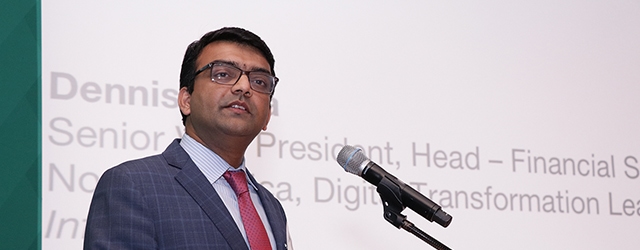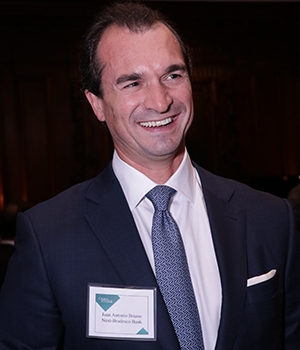Improving the customer journey and streamlining internal processes are at the heart of the changes this year’s Best Digital Bank award winners are making.
 Dennis Gada, digital transformation leader for Infosys, made the keynote address at Global Finance’s Best Digital Bank Awards ceremony at the Harvard Club in New York City. |
Digital transformation, most banks are coming to realize, is an ongoing process with no clear end result. Too many have yet to apply the lesson, however. Legacy core banking systems continue to stymie efforts to provide a seamless customer experience, even as banks learn that a digital front end is not nearly enough; and a digital strategy that does not solve architecture issues results only in worse customer experience and technical debt (the implied costs of retrofitting legacy code to suit modern systems).
This year’s Global Finance Best Digital Bank Awards recognizes those that have absorbed the lessons of this era of rapid change and taken creative and foresightful steps to make their core businesses align with the needs of an increasingly digital-native customer base. The awards were presented on October 29 at the Harvard Club in New York City.
The complexity of legacy platforms and the mission-critical nature of banking services mean that the cloud and open application programming interfaces (APIs) are now critical enablers for banks, says Shanker Ramamurthy, general manager of strategy and market development for global industries, platforms and blockchain at IBM. “These legacy systems were built over decades and with layer upon layer of complexity,” he says. “You can’t just migrate in one giant leap. You have got to build micro services and thoughtfully transition pieces of functionality, so that you’re able to access it through APIs to achieve nimbleness and flexibility.”

Hans Brown of BNY Mellon, which was recognized for its Global Innovation Centers. |
When it comes to the customer’s digital experience, benchmarks are set not just by competing financial institutions, but by the full range of online enterprises. “Banks are operating in an e-commerce world, where they are competing for attention with the likes of Facebook and Amazon and their elegant and simple interfaces that have very high net promoter scores,” says Ramamurthy. “Financial institutions have to respond to that.”
Plenty of competition within their own industry is pushing legacy banks in the same direction. “With the challenge of new competition, shifting customer expectations and the emergence of new technologies, traditional banks can no longer rely on outdated practices,” says Sudeepto Mukherjee, senior vice president and banking and insurance head for Europe, the Middle East and Africa, and for Asia and the Pacific, at digital-transformation consultant Publicis Sapient. “They need to adapt to these changes to close the gap between themselves and the digital-native challenger banks today, and not tomorrow.”
Consumer Focus
Standard Chartered, this year’s Best Consumer Digital Bank, undertook a range of digital initiatives last year, including new-account sign-ups via a mobile app, cardless payments and cash withdrawals, digital wealth-management options and a self-learning chatbot powered by artificial intelligence (AI).
Best Consumer Digital Bank in Western Europe and Best Mobile Banking App went to CaixaBank. “Banks are operating in an environment where digital channels, and mobile in particular are at the core of the customer relationship,” says CEO Gonzalo Gortázar. “They need to constantly adjust to the rapid development of technology and the new demands of customers and regulators both.”
Banks must focus on client experience, further integration of channels and evolving the traditional branch model into new formats. “On the operational side,” Gortázar says, CaixaBank is “focusing on the transformation of the operating model to successfully evolve our systems and become more agile in our time to market.”
These priorities are at the core of the bank’s strategy for the coming years: to make sure it delivers the best commercial offering to its customer base, which in turn will attract greater market share. “We are proud to be the leader in the digital-banking market in Spain,” Gortázar says, with the largest base of digital customers: 6.3million, or 60.5% of the bank’s Spanish retail customers, which it aims to raise to 70% by 2021.
Underscoring the need to gear offerings to an increasingly younger customer base, Boubyan Bank, this year’s Best Islamic Digital Bank, has undertaken a major upgrade of its core banking platform to provide greater insights and hasten the time to market for new products aimed at a younger, digital-native population.
Agile Customer Service
Time to market is also a priority for Poland’s mBank, which won the award for Best Corporate/Institutional Digital Bank in Central & Eastern Europe (CEE) on the strength of an agile project methodology that enables its customers to regularly enjoy new features and solutions.
Citi takes home multiple awards this year, thanks to its focus on providing customers with flexibility and control across all channels by way of an ongoing digital transformation that empowers users to adopt, customize and engage with ease, regardless of size and location. Citi was recognized as the World’s Best Digital Bank and Global Best Corporate/Institutional Digital Bank.
Enterprise resource planning (ERP) systems are at the core of client’s businesses, where they manage tasks including inventory, vendor relationships, client engagements and invoicing, says Mayank Mishra, global product head of digital channel services at Citi Treasury and Trade Solutions. “A natural extension of these ERP systems is treasury software,” he says, “where the clients manage their working capital including DPOs [days payable outstanding] and DSOs [days sales outstanding].” Seamless connectivity and integration with their banks are absolutely critical for clients to operate securely, efficiently and in a timely manner. As a result, “these ecosystems have evolved to become digital, or in recent cases have been launched as digital ecosystems exclusively,” Mishra says.
Citi’s strategy “is focused on seamless, frictionless integration with our customers,” he adds, “as well as being a network bank connected to ecosystems that create value for our clients.”
Through focused innovations, strategic partnerships and open collaboration with clients, fintech and other partners, Citi continues to expand its digital presence, which includes real-time financial transaction processing through deeply integrated solutions and open-banking partnerships.

Amy Dixon, associate vice president of Infosys. |
“As transition into cloud-based, virtualized solutions continues, ecosystems will continue to increase in significance,” says Mishra. “This is starting to shift from clients interacting with banks away from traditional bank portals and proprietary platforms toward embedded treasury-software solutions on the corporate side of the firewall and bank-agnostic networks.”
Evolve, Attack, and Jump
Mukherjee describes three models of digital business transformation that established banks can adopt: evolve, jump and attack.
“Evolving to a customer-led model, from both an organizational and incentive perspective; and going on the attack by launching a new enterprise within a self-contained business core; and driving incremental revenue quickly, have proven successful for the big players,” Mukherjee says. “To ‘jump,’ i.e., take a risk for potentially the highest reward, involves creating a new shell that the existing business can migrate onto. This is less about incremental change and more about jumping in feet first.”
“While natural inertia will make most organizations focus entirely on fixing current issues via ‘evolve’, we feel that it’s important to have a more holistic approach where investments and time is directed towards ‘jump’ and ‘attack’ models to future proof their businesses and drive innovation,” addsMukherjee.
Another institution that favors the jump and attack models is Russia’s Tinkoff Bank, which won the awards for Best Consumer Digital Bank in CEE and Best Corporate/Institutional Information Security and Fraud Management. Tinkoff launched its own supercomputer in April, Kolmogorov, which aims to accomplish machine learning and AI tasks hundreds of times faster than conventional methods. Using Kolmogorov, it took Tinkoff just 24 hours to retrain a sales-probability forecasting model on its entire 13-year set of accumulated data as part of the bank’s outgoing calls optimization effort, down from an estimated six months using its older tools.
Tinkoff’s compatriot Sberbank won this year’s awards for Best Bill Payment and Presentment and Best in Corporate/Institutional Social Media Marketing and Services. As part of its effort to keep pace with consumers’ changing payment habits, Sberbank is partnering with third parties, including a $1billion taxi and food delivery joint venture with Mail.ru, a 45% stake in a $1billion e-commerce joint venture with Yandex and a 46.5% stake in media and entertainment group Rambler.

Juan Antonio Briano of Next-Bradesco Bank, Best Consumer Digital Bank in Brazil |
Concentrating on front-end interaction, Slovakia’s Tatra banka won as this year’s Most Innovative Consumer Digital Bank. Tatra launched a new website with a more intuitive design and fully responsive mobile app, along with such innovations as face biometric sign-ins for new customers and a heat-map technology to trace customer preferences. Argentina’s Santander Rio, which won as Best Consumer Digital Bank in Latin America, opened four digital branches, or “work cafés,” offering bank-branch services, coworking spaces and cafeteria services for clients and nonclients both.
Thinking Like a Fintech
Georgia’s TBC Bank, this year’s winner of the Best in Consumer Mobile Banking award, rolled out its financial app Space in May 2018. Since then, it has attracted over 400,000 downloads in a market with a population of just 4million, underscoring the strength of demand for mobile banking even in developing markets. CEO Vakhtang Butskhrikidze says TBC has plans to roll out Space in its other markets, such as Israel and Azerbaijan.
“Space is a neobank that exists only as a mobile app and is therefore completely separate from our traditional banking business,” Butskhrikidze says. “We have managed to create a unique customer experience that strives to make banking simple, friendly and fun. Through Space, we learned to think like a fintech company and see banking from a different angle, from people to processes and culture.”
Customers expect highly personalized, fully fledged solutions, delivered quickly and seamlessly. That makes it important for banks to constantly reinvent themselves, says Butskhrikidze, “expanding our value proposition beyond banking, via development of innovative customer-centric digital ecosystems.”
Application of data analytics and AI will bring mobile banking usage to the next level, he predicts: “This will mean more targeted solutions, fewer boundaries and more lifestyle offerings, resulting in significant enhancement of user experience. In this regard, TBC is a leader in the markets in which it operates. We have already established data analytics capabilities, learning from the world-class leaders in this field; and we have started developing customer-centric digital ecosystems.”
ING, which captured the Best Integrated Corporate Banking Site award, is beginning to enjoy the fruits of its investment in fintech partners, including MineHub, a mining technology company; and a partnership with Google and PwC to provide an early warning system for credit risk analysts. An AI-based pricing assistant, Katana, helps bond traders to improve accuracy and efficiency; while consumers using ING’s German banking app can access predictive analytics displaying their upcoming debits 35 days in advance, helping them to better manage their finances.
Corporates increasingly demand meaningful data that takes into account their different geographies as well as macroeconomic trends; and this in turn is boosting demand for data-rich cash-management forecasting, says Sanat Rao, chief business officer and global head of Infosys’ Finacle universal banking solution. “It’s making it more incumbent on banks to be able to provide actionable insights,” he says, “enabling corporate customers to leverage the data to carry out cash management and pooling of funds more effectively.”
Open banking and similar initiatives are making it easier for banks to meet the demand, he adds, by “creating an environment where there will be more sharing of information, allowing other parties to come in and be part of the ecosystem. We are moving in the direction where banks will have no option but to provide this kind of information.”
One institution that has grasped the opportunity is Emirates NBD, which won for Best Integrated Consumer Banking Site this year. Emirates NBD is the first global bank to implement the SAP Financial Services Data Platform to deliver customer intelligence across all of its market segments, entities and countries. “Being increasingly effective and efficient in both harvesting and leveraging our growing critical data is core to Emirates NBD’s digital transformation,” Abdulla Qassem, group chief operating officer, said on announcing this second phase of expansion for the bank’s enterprise data platform.
Home-loan decisions are assuming a digital profile as well. Saudi Arabia’s Bidaya Home Finance, this year’s Best Mortgage Bank, utilizes Decision Smart System, an automated loan-decision algorithm, to determine whether it can offer mortgages to individuals overlooked by other lenders.
Singapore’s DBS, which took the Best Website Design award for Consumer Banking and Best Online Portal Services for Corporate/Institutional Banking is now profiling itself as a tech firm as much as a bank, having reimagined its processes, digitized everything from end to end with the help of APIs and adopted agile working methods across the board.
How are these innovations shaping the world of banking in, say, the next 10 to 20 years? Bidyut Dumra, executive director and head of innovation at DBS, says the future of banking is “invisible”: services will be seamlessly and intuitively embedded into customers’ lives.
The other side of the same coin is innovations that streamline banks’ internal operations. TBC Bank for example, launched an agile transformation project this year starting with its retail and MSME (micro, small and medium-size enterprise) departments. “This is a huge transformation in the bank culture, which aims to simplify processes and reduce bureaucracy,” says Butskhrikidze. “It has already significantly improved staff engagement, commitment and creativity; and we are seeing an increase in efficiency levels, faster time to market and an ever more innovative environment.”
While examples of digital banking transformation are multiplying, the successful ones, including many of this year’s award winners, are focused on the core of their business and incrementally improving it. Borrowing from agile software-development practices, they needn’t modernize their legacy systems in one big bang, when technologies such as the cloud and APIs allow for incremental implementations that reduce risks and create flexibility. This helps create an improved customer journey, which our winners largely agree should be the driving force behind any change.
|
WORLD’S BEST DIGITALBANKS 2019— ROUND 2 |
|---|
Global Winners |
|
|---|---|
| World’s Best Digital Bank | Citi |
| Best Corporate/Institutional Digital Bank | Citi |
| Best Consumer Digital Bank | Standard Chartered |
| Best Islamic Digital Bank | Boubyan Bank |
Regional Winners— Corporate/Institutional |
|
|---|---|
| North America | Wells Fargo |
| Latin America | Citi |
| Western Europe | Citi |
| Central & Eastern Europe | mBank |
| Asia-Pacific | Citi |
| Middle East | Citi |
| Africa | Citi |
Regional Winners— Consumer |
|
|---|---|
| North America | CIBC |
| Latin America | Santander Rio |
| Western Europe | CaixaBank |
| Central & Eastern Europe | Tinkoff Bank |
| Asia-Pacific | Standard Chartered |
| Middle East | NCB |
| Africa | Standard Chartered |
Global Sub-Category Winners — Corporate/Institutional |
|
|---|---|
| Best Investment Management Services | Citi |
| Best Online Cash Management | Citi |
| Best Trade Finance Services | Wells Fargo |
| Best Online Portal Services | DBS Bank |
| Best Integrated Corporate Banking Site | ING Bank |
| Best Information Security and Fraud Management | Tinkoff Bank |
| Best Online Treasury Services | Citi |
| Best in Mobile Banking | Citi |
| Best in Social Media Marketing and Services | Sberbank |
| Best Mobile Banking App | Citi |
| Most Innovative Digital Bank | Citi |
| Best Open Banking APIs | Citi |
Global Sub-Category Winners — Consumer |
|
|---|---|
| Best Online Deposit, Credit and Investment Product Offerings | Taipei Fubon Bank |
| Best Bill Payment and Presentment | Sberbank |
| Best Website Design | DBS Bank |
| Best Integrated Consumer Banking Site | Emirates NBD |
| Best in Mobile Banking | TBC Bank |
| Best Information Security and Fraud Management | Banco Popular Puerto Rico |
| Best in Social Media Marketing and Services | Taishin Bank |
| Best Mobile Banking App | CaixaBank |
| Most Innovative Digital Bank | Tatra banka |
| Best Mortgage Bank | Bidaya Home Finance |
| Best Open Banking APIs | Citi |


